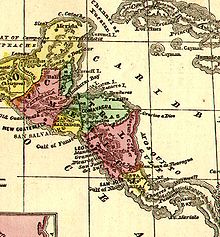History of Central America
The history of Central America is the history of the Central America region made up of the Central American Land Bridge , the Caribbean Islands, and the United Mexican States .
The chronological table of human history offers a chronological and geographical overview of the embedding of this epoch in human history .
Prehistory and early history of Central America
Central America has been inhabited by humans for around 10,000 years. It is believed in American history that these first inhabitants immigrated from Asia via North America.
However, there is a controversial discussion about this theory, as there are finds that indicate a much earlier settlement of the region: for example at Tlapacoya (approx. 20,000 to 22,000 BC).
Pre-Columbian period
The Aztecs reached a high level of culture in the middle of Mexico and the Maya in the border area between today's states of Mexico and Guatemala .
While the Mayan civilization fell into disrepair in the 10th century in a way that had not yet been conclusively clarified, the empire of the Aztecs was in full bloom when the Spaniards arrived. It originated in the middle of the 14th century and was crushed by the Spanish under Cortés in 1520 . The capital Tenochtitlán then became the capital of the country of the same name as Mexico City .
Colonial times
Central America became part of the viceroyalty of New Spain , from which the Mexican Empire under Agustín I (civil: Agustín de Iturbide ) emerged in 1821 .
19th century
In 1823 the Central American Confederation was founded , consisting of Guatemala , Honduras , El Salvador , Nicaragua , and Costa Rica . In 1830 Los Altos (now the western highlands of Guatemala and the Chiapas province of Mexico) joined the federation.
After a number of presidents (1823 José Cecilo del Valle ; 1825 Manuel José Arce ; 1829 José F. Barrundia ; 1830–1839 Francisco Morazán ) the unity was lost in the civil war (1838–1840). Attempts at reunification in the 19th century were unsuccessful.
The states of the Caribbean have very different histories. What they have in common, however, is that, with the exception of Cuba, Puerto Rico and the Dominican Republic, the islands have been wrested from Spanish influence by the colonial powers England, France and the Netherlands since the 16th century. The last Spanish colonial territories became dependent on the USA after the Spanish-American War . On all the Caribbean islands, the Indian population was largely exterminated and large numbers of African slaves were used as plantation workers. In contrast to the mainland, the Caribbean states (apart from Haiti, the Dominican Republic and Cuba) gained their independence relatively late, namely in the second half of the 20th century. In addition, there are still some dependent areas that belong to France, Great Britain, the USA and the Netherlands.
History of nation states
- History of Barbados
- History of Belize
- History of Costa Rica
- History of the Bahamas
- History of the Dominican Republic
- History of Dominica
- History of El Salvador
- History of Guatemala
- History of Haiti
- History of Honduras
- History of Cuba
- History of Nicaragua
- History of Panama
- History of St. Lucia
- History of Trinidad and Tobago
literature
- Walter LaFeber: Inevitable Revolutions. The United States in Central America . Norton, New York 1993, ISBN 978-0-393-30964-5
- Ralph Lee Woodward: Central America. A Nation Divided . 3. Edition. Oxford University Press, New York 1999, ISBN 978-0-19-508376-7 .


